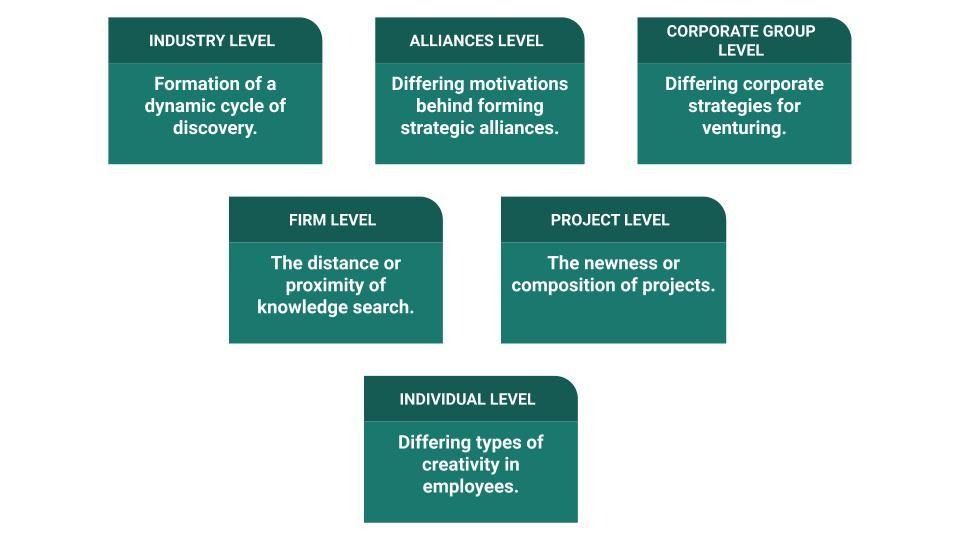Innovation is often echoed in the business world. The colossal impact of the pandemic on the business and economy has only increased the necessity for innovating. While this can be equally stressful and exciting, it is important to understand this concept further past its standard definition.
The upsides and downsides of innovation are well known; it demands high investment but when implemented right, it can potentially create incredible growth and value for a corporation. But the approaches to innovation are the lesser-known ones.
Two Approaches To Innovation:
The two distinct approaches to innovation are exploration and exploitation. Exploration involves innovating from scratch, starting afresh, while exploitation involves building new methods based on existing resources and products. Both these approaches can lead to innovation, but they come from two different perspectives.
These two approaches broadly deal with different domains in a corporation. Exploration deals with the technological domain, and exploitation deals with the market domain. Therefore, exploration involves research and discovering technological knowledge, whereas exploitation involves gaining access to market knowledge. For instance, the first-ever iPhone introduced by Apple can be classified as explorative innovation, and all the subsequent editions of iPhones can be classified as exploitative innovation. Although every edition of the iPhone goes through a certain degree of innovation, it is mostly exploitation of the existing technology, aimed to retain existing customers.
Similarly, Spotify, the Swedish music streaming platform, had disrupted the music industry. The platform was the first of its kind, and despite facing substantial criticism for providing artists with unsustainable income’, it has now successfully internationalised. Since its commencement in 2008, the platform has brought in several updates such as premium membership, yearly review (Spotify Wrapped),, and short-term memberships (daily, weekly, etc.). So, the original platform can be classified as explorative innovation and the updates can be classified as exploitative innovation.

Effects On Different Levels:
So, now that the distinction between the two has been established, these approaches cause definite effects and influences on different levels, scaling from the individual level to the industry level. At an individual level, exploration is believed to foster a divergent form of creativity, whereas exploitation is believed to foster incremental creativity among employees. Divergent creativity is the act of generating ideas that are far from existing knowledge and resources. Incremental creativity is more about adapting or modifying the present knowledge and resources to utilise them better.
Similarly, at an alliance level, the motivation behind forming alliances is influenced either by the exploitation or exploration approach. In the case of the exploration approach, strategic alliances formed tend to be research and development alliances, whereas, in the exploitation approach, firms tend to form commercial alliances. For example, the Uber and Spotify alliance was purely a marketing alliance. Uber and Spotify belong to completely different industries and are largely unrelated, the alliance aimed to simply reach out to each other’s pool of customers, therefore it was a market-based alliance.
Likewise, at a corporate group level, the exploration approach leads to the formation of a new subsidiary while the exploitation approach leads to better utilisation of the existing subsidiaries of a company.
To Explore Or To Exploit:
Exploitative innovation is far more common in corporations than explorative innovation. Corporations tend to innovate in their set industry, business model, product line, etc. rather than disrupting their entire company. Explorative innovation occurs seldom due to its disruptive tendencies. Furthermore, a few explorative innovations end up not only disrupting their own business but also the entire industry. For example, Uber disrupted the taxi industry by bringing in the concept of a shared economy, this didn’t just affect their business but affected the other players in the industry such as black cab drivers in London, auto drivers in India, etc.
Exploitative innovation, although profitable, is subtle and incremental in nature and the risk involved in this approach of innovation is limited. For example, most companies update or innovate within the services or features of the products that already exist in their portfolio for example Coca Cola, Cadbury, etc. This approach is more common due to its limited risk and in a few cases, due to its high profitability.
Both these approaches have their pros and cons. They are both impactful and profitable, although up to different degrees. For years, innovation has been discussed as a luxurious practice facilitated by large corporations but now innovation is needed to be done by companies of all sizes. There is no ideal approach to innovation, perhaps maintaining an innovation portfolio with a balance of exploration and exploitation can prove to be efficient as either approach can be used as per the need and requirement.
– Rakshaan Fatima, Business Development Associate, T-Hub
Innovation is often echoed in the business world. The colossal impact of the pandemic on the business and economy has only increased the necessity for innovating. While this can be equally stressful and exciting, it is important to understand this concept further past its standard definition.
The upsides and downsides of the innovation ecosystem are well known; it demands high investment but when implemented right, it can potentially create incredible growth and value for a corporation. But the approaches to innovation are often overlooked, and don’t get the limelight they deserve.
Two Approaches To Innovation
The two distinct approaches to innovation are exploration and exploitation. Exploration involves innovation from scratch, starting afresh, while exploitative innovation is building new methods based on existing resources and products. Both these approaches can lead to innovation, but they come from two different perspectives.
These two approaches broadly deal with different domains in a corporation. Exploration deals with the technological domain, and exploitation deals with the market domain. Therefore, explorative innovation involves research and discovering technological knowledge. On the other hand, exploitation involves gaining access to market knowledge.
For instance, the first-ever iPhone introduced by Apple can be classified as explorative innovation, and all the subsequent editions of iPhones can be classified as exploitative innovation. Although every edition of the iPhone goes through a certain degree of innovation, it is mostly exploitation of the existing technology, aimed to retain existing customers.
Similarly, Spotify, the Swedish music streaming platform, had disrupted the music industry. The platform was the first of its kind, and despite facing substantial criticism for providing artists with unsustainable income’, it has now successfully internationalised. Since its commencement in 2008, the platform has brought in several updates such as premium membership, yearly review (Spotify Wrapped), and short-term memberships (daily, weekly, etc.). So, the original platform can be classified as explorative innovation and the updates can be classified as exploitative innovation.
Effects On Different Levels
So, now that the distinction between the two has been established, these approaches cause definite effects and influences on different levels, scaling from the individual level to the industry level. At an individual level, exploration is believed to foster a divergent form of creativity, whereas exploitation is believed to foster incremental creativity among employees. Divergent creativity is the act of generating ideas that are far from existing knowledge and resources. Incremental creativity is more about adapting or modifying the present knowledge and resources to utilise them better.

Similarly, at an alliance level, the motivation behind forming alliances is influenced either by the exploitation or exploration approach. In the case of the exploration approach, strategic alliances formed tend to be research and development alliances, whereas, in the exploitation approach, firms tend to form commercial alliances. For example, the Uber and Spotify alliance was purely a marketing alliance. Uber and Spotify belong to completely different industries and are largely unrelated, the alliance aimed to simply reach out to each other’s pool of customers, therefore it was a market-based alliance.
Likewise, at a corporate group level, the exploration approach leads to the formation of a new subsidiary while the exploitation approach leads to better utilisation of the existing subsidiaries of a company.
To Explore Or To Exploit
Exploitative innovation is far more common in corporations than explorative innovation. Corporations tend to innovate in their set industry, business model, product line, etc. rather than disrupting their entire company.
Explorative innovation occurs seldom due to its disruptive tendencies. Furthermore, a few explorative innovations end up not only disrupting their own business but also the entire industry. For example, Uber disrupted the taxi industry by bringing in the concept of a shared economy, this didn’t just affect their business but affected the other players in the industry such as black cab drivers in London, auto drivers in India, etc.
Exploitative innovation, although profitable, is subtle and incremental in nature and the risk involved in this approach of innovation is limited. For example, most companies update or innovate within the services or features of the products that already exist in their portfolio for example Coca Cola, Cadbury, etc. This approach is more common due to its limited risk and in a few cases, due to its high profitability.
Both these approaches have their pros and cons in the innovation ecosystem. They are both impactful and profitable, although up to different degrees. For years, innovation has been discussed as a luxurious practice facilitated by large corporations but now innovation needs to be done by companies of all sizes. There is no ideal approach to innovation, perhaps maintaining an innovation portfolio with a balance of exploration and exploitation can prove to be efficient as either approach can be used as per the need and requirement.






